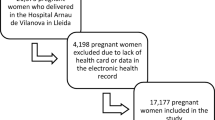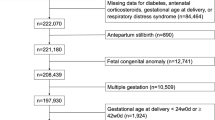Abstract
Objective:
To identify the optimal gestational age (GA) for induction of labor (IOL) at term among patients with gestational diabetes (GDMA) according to perinatal outcomes.
Study Design:
The US Natality Database from 2007 to 2010 was reviewed. Inclusion criteria were singleton delivery, IOL at 37 to 42 weeks and GDMA. Exclusion criteria included congenital anomalies, pre-gestational diabetes, hypertensive disorders, previous cesarean, breech presentation and rupture of membranes. Controls were non-GDMA cases delivered in geographic and temporal proximity. Delivery mode, macrosomia and perinatal complications were analyzed. Logistic regression adjusted for confounders was used to calculate odds ratios by GA using 39 weeks non-GDMA as reference.
Results:
In all, 96 964 cases and 176 079 controls were included. Increased risk for all adverse outcomes among GDMA cases was found. The nadir for intrapartum and neonatal complications was 38 and 40 weeks, respectively, whereas for cesarean and macrosomia was 39 weeks.
Conclusion:
The optimal timing for IOL at term in GDMA appears to be 39 to 40 weeks.
This is a preview of subscription content, access via your institution
Access options
Subscribe to this journal
Receive 12 print issues and online access
$259.00 per year
only $21.58 per issue
Buy this article
- Purchase on Springer Link
- Instant access to full article PDF
Prices may be subject to local taxes which are calculated during checkout





Similar content being viewed by others
References
Hunt KJ, Schuller KL . The increasing prevalence of diabetes in pregnancy. Obstet Gynecol Clin North Am 2007; 34 (2): 173–199, vii.
Committee on Practice Bulletins-Obstetrics. Practice bulletin No. 137: gestational diabetes mellitus. Obstet gynecol 2013; 122 (2 Pt 1): 406–416.
Group HSCR, Metzger BE, Lowe LP, Dyer AR, Trimble ER, Chaovarindr U et al. Hyperglycemia and adverse pregnancy outcomes. N Engl J Med 2008; 358 (19): 1991–2002.
Jovanovic L, Pettitt DJ . Gestational diabetes mellitus. JAMA 2001; 286 (20): 2516–2518.
Sutton AL, Mele L, Landon MB, Ramin SM, Varner MW, Thorp JM Jr et al. Delivery timing and cesarean delivery risk in women with mild gestational diabetes mellitus. Am J Obstet Gynecol 2014; 211 (3): 244.e1–e7.
Kjos SL, Henry OA, Montoro M, Buchanan TA, Mestman JH . Insulin-requiring diabetes in pregnancy: a randomized trial of active induction of labor and expectant management. Am J Obstet Gynecol 1993; 169 (3): 611–615.
Conway DL, Langer O . Elective delivery of infants with macrosomia in diabetic women: reduced shoulder dystocia versus increased cesarean deliveries. Am J Obstet Gynecol 1998; 178 (5): 922–925.
Lurie S, Insler V, Hagay ZJ . Induction of labor at 38 to 39 weeks of gestation reduces the incidence of shoulder dystocia in gestational diabetic patients class A2. Am J Perinatol 1996; 13 (5): 293–296.
Peled Y, Perri T, Chen R, Pardo J, Bar J, Hod M . Gestational diabetes mellitus–implications of different treatment protocols. J Pediatr Endocrinol Metab 2004; 17 (6): 847–852.
Mitanchez D . Foetal and neonatal complications in gestational diabetes: perinatal mortality, congenital malformations, macrosomia, shoulder dystocia, birth injuries, neonatal complications. Diabetes Metab 2010; 36 (6 Pt 2): 617–627.
Mitanchez D, Burguet A, Simeoni U . Infants born to mothers with gestational diabetes mellitus: mild neonatal effects, a long-term threat to global health. J Pediatr 2014; 164 (3): 445–450.
Witkop CT, Neale D, Wilson LM, Bass EB, Nicholson WK . Active compared with expectant delivery management in women with gestational diabetes: a systematic review. Obstet Gynecol 2009; 113 (1): 206–217.
Spong CY, Mercer BM, D'Alton M, Kilpatrick S, Blackwell S, Saade G . Timing of indicated late-preterm and early-term birth. Obstet Gynecol 2011; 118 (2 Pt 1): 323–333.
Stotland NE, Caughey AB, Breed EM, Escobar GJ . Risk factors and obstetric complications associated with macrosomia. Int J Gynaecol Obstet 2004; 87 (3): 220–226.
McLaughlin GB, Cheng YW, Caughey AB . Women with one elevated 3-hour glucose tolerance test value: are they at risk for adverse perinatal outcomes? Am J Obstet Gynecol 2006; 194 (5): e16–e19.
Olofsson P, Ingemarsson I, Solum T . Fetal distress during labour in diabetic pregnancy. Br J Obstet Gynaecol 1986; 93 (10): 1067–1071.
Fadl HE, Ostlund IK, Magnuson AF, Hanson US . Maternal and neonatal outcomes and time trends of gestational diabetes mellitus in Sweden from 1991 to 2003. Diabet Med 2010; 27 (4): 436–441.
Rayburn WF, Sokkary N, Clokey DE, Moore LE, Curet LB . Consequences of routine delivery at 38 weeks for A-2 gestational diabetes. J Matern fetal Neonatal Med 2005; 18 (5): 333–337.
Acker DB, Sachs BP, Friedman EA . Risk factors for shoulder dystocia. Obstet Gynecol 1985; 66 (6): 762–768.
Alberico S, Montico M, Barresi V, Monasta L, Businelli C, Soini V et al. The role of gestational diabetes, pre-pregnancy body mass index and gestational weight gain on the risk of newborn macrosomia: results from a prospective multicentre study. BMC Pregnancy Childbirth 2014; 14: 23.
Lurie S, Matzkel A, Weissman A, Gotlibe Z, Friedman A . Outcome of pregnancy in class A1 and A2 gestational diabetic patients delivered beyond 40 weeks' gestation. Am J Perinatol 1992; 9 (5–6): 484–488.
Mimouni F, Miodovnik M, Siddiqi TA, Khoury J, Tsang RC . Perinatal asphyxia in infants of insulin-dependent diabetic mothers. J Pediatr 1988; 113 (2): 345–353.
Cordero L, Treuer SH, Landon MB, Gabbe SG . Management of infants of diabetic mothers. Arch Pediatr Adolesc Med 1998; 152 (3): 249–254.
Gewolb IH, O'Brien J . Surfactant secretion by type II pneumocytes is inhibited by high glucose concentrations. Exp Lung Res 1997; 23 (3): 245–255.
Taricco E, Radaelli T, Rossi G, Nobile de Santis MS, Bulfamante GP, Avagliano L et al. Effects of gestational diabetes on fetal oxygen and glucose levels in vivo. BJOG 2009; 116 (13): 1729–1735.
Ostlund I, Hanson U, Bjorklund A, Hjertberg R, Eva N, Nordlander E et al. Maternal and fetal outcomes if gestational impaired glucose tolerance is not treated. Diabetes Care 2003; 26 (7): 2107–2111.
Nold JL, Georgieff MK . Infants of diabetic mothers. Pediatr Clin North Am 2004; 51 (3): 619–637 viii.
Piper JM . Lung maturation in diabetes in pregnancy: if and when to test. Semin Perinatol 2002; 26 (3): 206–209.
Dudley DJ . Diabetic-associated stillbirth: incidence, pathophysiology, and prevention. Clin Perinatol 2007; 34 (4): 611–626, vii.
Langer O, Rodriguez DA, Xenakis EM, McFarland MB, Berkus MD, Arrendondo F . Intensified versus conventional management of gestational diabetes. Am J Obstet Gynecol 1994; 170 (4):1036–1046 discussion 1046–1047.
Author information
Authors and Affiliations
Corresponding author
Ethics declarations
Competing interests
The authors declare no conflict of interest.
Rights and permissions
About this article
Cite this article
Vilchez, G., Dai, J., Hoyos, L. et al. Labor and neonatal outcomes after term induction of labor in gestational diabetes. J Perinatol 35, 924–929 (2015). https://doi.org/10.1038/jp.2015.103
Received:
Revised:
Accepted:
Published:
Issue Date:
DOI: https://doi.org/10.1038/jp.2015.103
This article is cited by
-
Contemporary epidemiology and novel predictors of uterine rupture: a nationwide population-based study
Archives of Gynecology and Obstetrics (2017)



